SCI/256 Version 6: Human Impact on Biogeochemical Cycles Worksheet
VerifiedAdded on 2021/06/14
|5
|906
|142
Homework Assignment
AI Summary
This assignment is a worksheet focusing on the human impact on biogeochemical cycles. It explores how everyday actions, such as using fertilizer, driving gasoline-powered cars, and constructing urban areas with impermeable surfaces, affect the nitrogen, carbon, and hydrologic cycles. The student provides detailed explanations, referencing sources to support their answers. The worksheet examines the effects of excess fertilizer on the nitrogen cycle, the impact of car emissions on both the nitrogen and carbon cycles, and how pavement and compacted soils in urban areas disrupt the hydrologic cycle by affecting water infiltration. The assignment aims to deepen understanding of environmental science concepts and the consequences of human activities on natural processes.
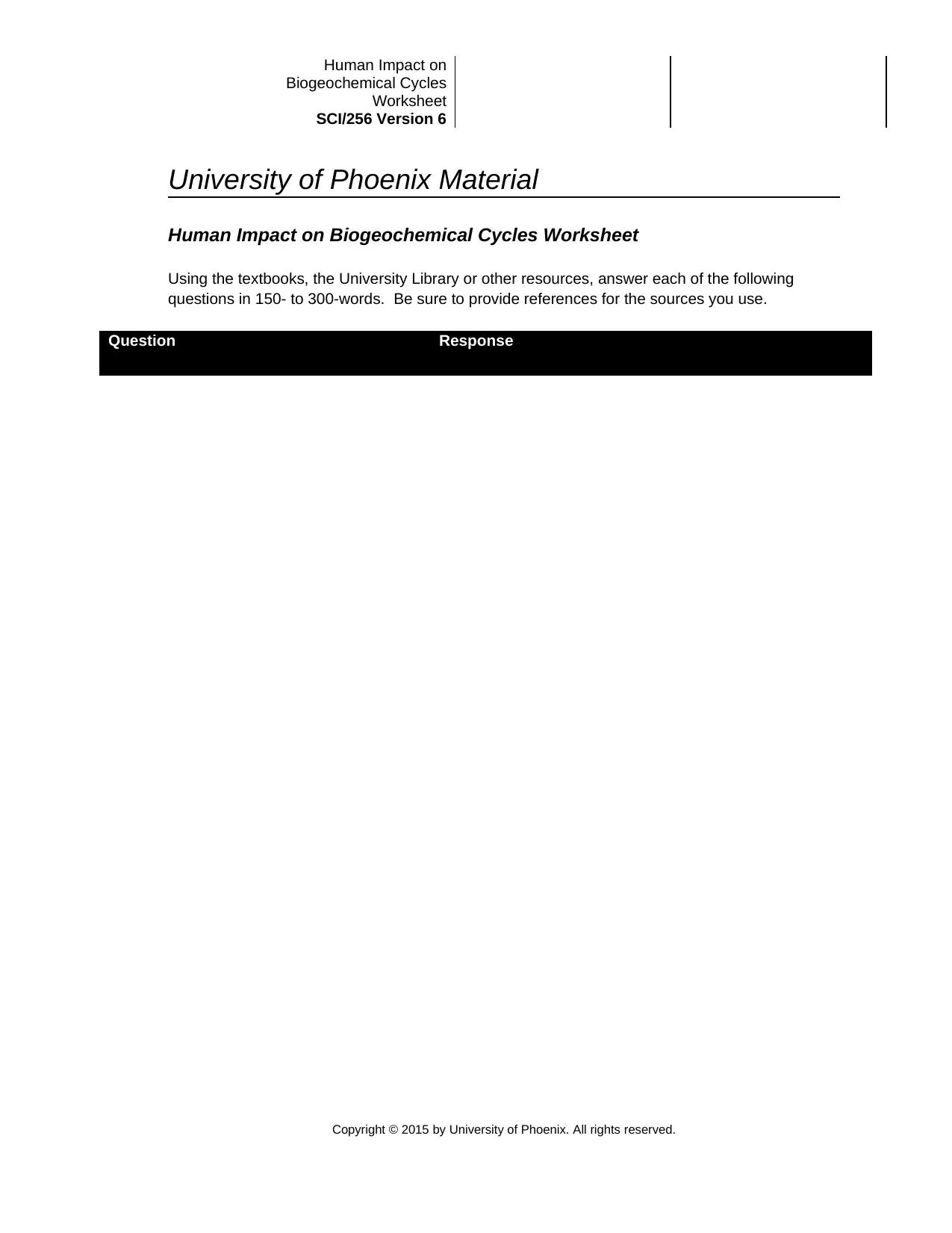
Human Impact on
Biogeochemical Cycles
Worksheet
SCI/256 Version 6
University of Phoenix Material
Human Impact on Biogeochemical Cycles Worksheet
Using the textbooks, the University Library or other resources, answer each of the following
questions in 150- to 300-words. Be sure to provide references for the sources you use.
Question Response
Copyright © 2015 by University of Phoenix. All rights reserved.
Biogeochemical Cycles
Worksheet
SCI/256 Version 6
University of Phoenix Material
Human Impact on Biogeochemical Cycles Worksheet
Using the textbooks, the University Library or other resources, answer each of the following
questions in 150- to 300-words. Be sure to provide references for the sources you use.
Question Response
Copyright © 2015 by University of Phoenix. All rights reserved.
Paraphrase This Document
Need a fresh take? Get an instant paraphrase of this document with our AI Paraphraser
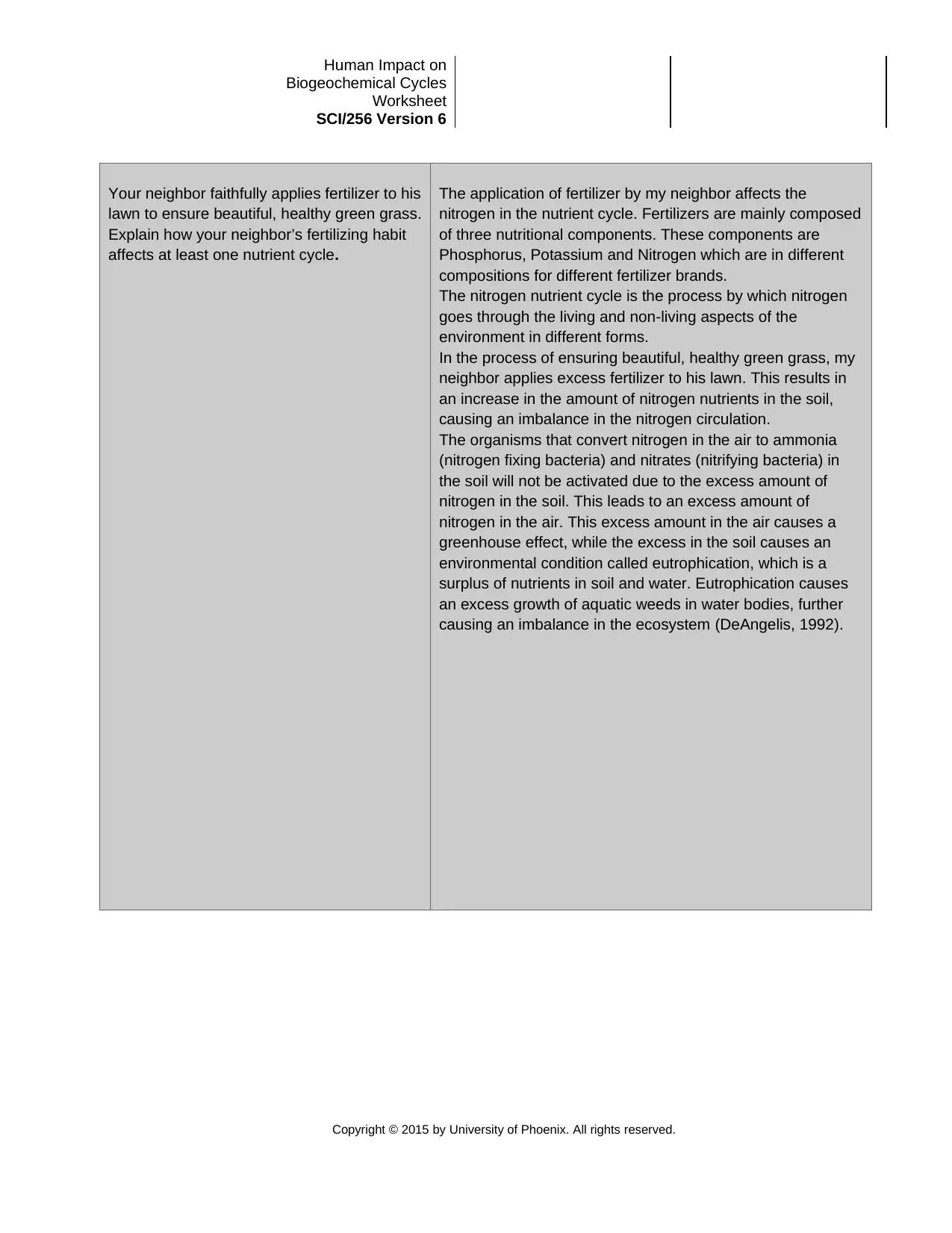
Human Impact on
Biogeochemical Cycles
Worksheet
SCI/256 Version 6
Your neighbor faithfully applies fertilizer to his
lawn to ensure beautiful, healthy green grass.
Explain how your neighbor’s fertilizing habit
affects at least one nutrient cycle.
The application of fertilizer by my neighbor affects the
nitrogen in the nutrient cycle. Fertilizers are mainly composed
of three nutritional components. These components are
Phosphorus, Potassium and Nitrogen which are in different
compositions for different fertilizer brands.
The nitrogen nutrient cycle is the process by which nitrogen
goes through the living and non-living aspects of the
environment in different forms.
In the process of ensuring beautiful, healthy green grass, my
neighbor applies excess fertilizer to his lawn. This results in
an increase in the amount of nitrogen nutrients in the soil,
causing an imbalance in the nitrogen circulation.
The organisms that convert nitrogen in the air to ammonia
(nitrogen fixing bacteria) and nitrates (nitrifying bacteria) in
the soil will not be activated due to the excess amount of
nitrogen in the soil. This leads to an excess amount of
nitrogen in the air. This excess amount in the air causes a
greenhouse effect, while the excess in the soil causes an
environmental condition called eutrophication, which is a
surplus of nutrients in soil and water. Eutrophication causes
an excess growth of aquatic weeds in water bodies, further
causing an imbalance in the ecosystem (DeAngelis, 1992).
Copyright © 2015 by University of Phoenix. All rights reserved.
Biogeochemical Cycles
Worksheet
SCI/256 Version 6
Your neighbor faithfully applies fertilizer to his
lawn to ensure beautiful, healthy green grass.
Explain how your neighbor’s fertilizing habit
affects at least one nutrient cycle.
The application of fertilizer by my neighbor affects the
nitrogen in the nutrient cycle. Fertilizers are mainly composed
of three nutritional components. These components are
Phosphorus, Potassium and Nitrogen which are in different
compositions for different fertilizer brands.
The nitrogen nutrient cycle is the process by which nitrogen
goes through the living and non-living aspects of the
environment in different forms.
In the process of ensuring beautiful, healthy green grass, my
neighbor applies excess fertilizer to his lawn. This results in
an increase in the amount of nitrogen nutrients in the soil,
causing an imbalance in the nitrogen circulation.
The organisms that convert nitrogen in the air to ammonia
(nitrogen fixing bacteria) and nitrates (nitrifying bacteria) in
the soil will not be activated due to the excess amount of
nitrogen in the soil. This leads to an excess amount of
nitrogen in the air. This excess amount in the air causes a
greenhouse effect, while the excess in the soil causes an
environmental condition called eutrophication, which is a
surplus of nutrients in soil and water. Eutrophication causes
an excess growth of aquatic weeds in water bodies, further
causing an imbalance in the ecosystem (DeAngelis, 1992).
Copyright © 2015 by University of Phoenix. All rights reserved.
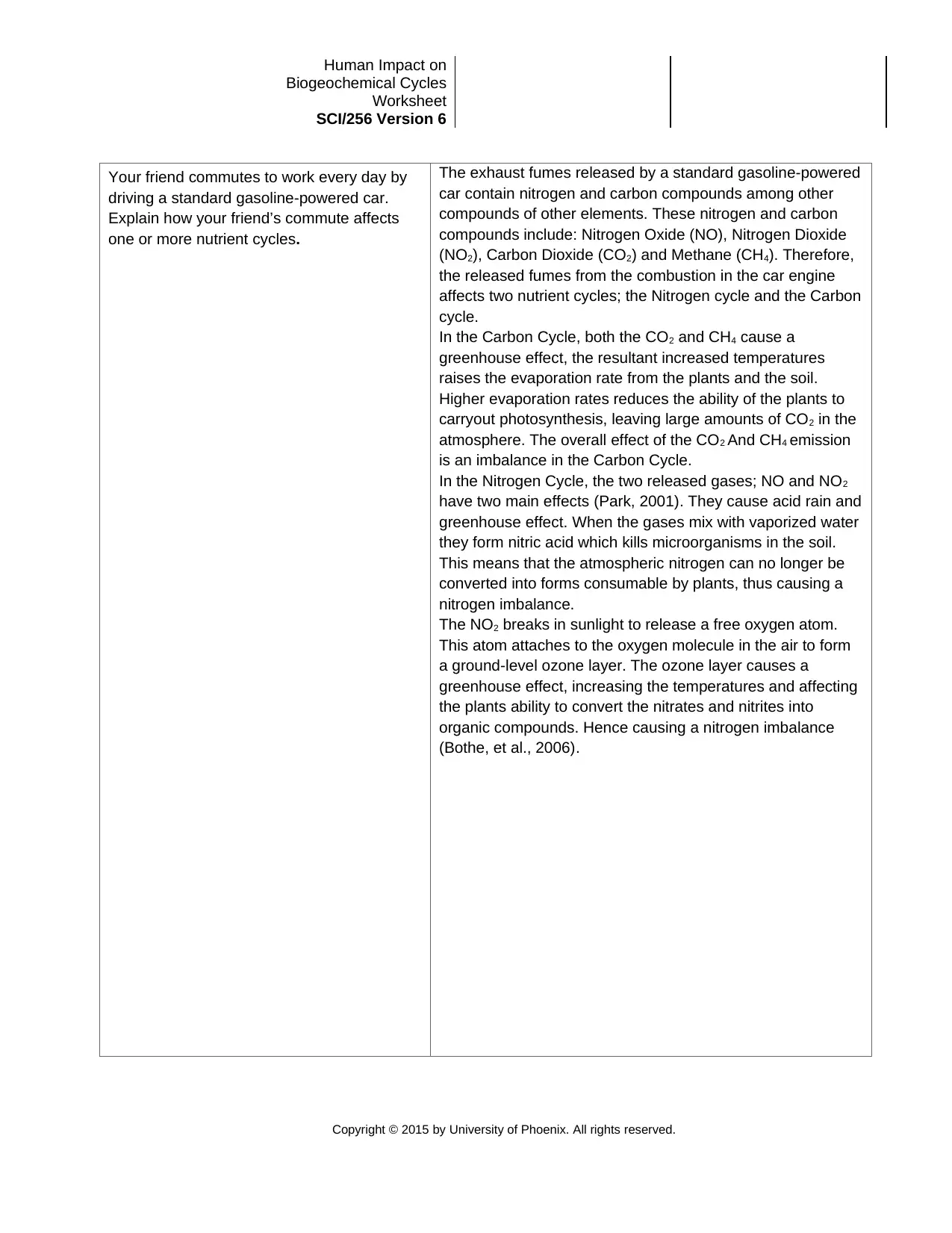
Human Impact on
Biogeochemical Cycles
Worksheet
SCI/256 Version 6
Your friend commutes to work every day by
driving a standard gasoline-powered car.
Explain how your friend’s commute affects
one or more nutrient cycles.
The exhaust fumes released by a standard gasoline-powered
car contain nitrogen and carbon compounds among other
compounds of other elements. These nitrogen and carbon
compounds include: Nitrogen Oxide (NO), Nitrogen Dioxide
(NO2), Carbon Dioxide (CO2) and Methane (CH4). Therefore,
the released fumes from the combustion in the car engine
affects two nutrient cycles; the Nitrogen cycle and the Carbon
cycle.
In the Carbon Cycle, both the CO2 and CH4 cause a
greenhouse effect, the resultant increased temperatures
raises the evaporation rate from the plants and the soil.
Higher evaporation rates reduces the ability of the plants to
carryout photosynthesis, leaving large amounts of CO2 in the
atmosphere. The overall effect of the CO2 And CH4 emission
is an imbalance in the Carbon Cycle.
In the Nitrogen Cycle, the two released gases; NO and NO2
have two main effects (Park, 2001). They cause acid rain and
greenhouse effect. When the gases mix with vaporized water
they form nitric acid which kills microorganisms in the soil.
This means that the atmospheric nitrogen can no longer be
converted into forms consumable by plants, thus causing a
nitrogen imbalance.
The NO2 breaks in sunlight to release a free oxygen atom.
This atom attaches to the oxygen molecule in the air to form
a ground-level ozone layer. The ozone layer causes a
greenhouse effect, increasing the temperatures and affecting
the plants ability to convert the nitrates and nitrites into
organic compounds. Hence causing a nitrogen imbalance
(Bothe, et al., 2006).
Copyright © 2015 by University of Phoenix. All rights reserved.
Biogeochemical Cycles
Worksheet
SCI/256 Version 6
Your friend commutes to work every day by
driving a standard gasoline-powered car.
Explain how your friend’s commute affects
one or more nutrient cycles.
The exhaust fumes released by a standard gasoline-powered
car contain nitrogen and carbon compounds among other
compounds of other elements. These nitrogen and carbon
compounds include: Nitrogen Oxide (NO), Nitrogen Dioxide
(NO2), Carbon Dioxide (CO2) and Methane (CH4). Therefore,
the released fumes from the combustion in the car engine
affects two nutrient cycles; the Nitrogen cycle and the Carbon
cycle.
In the Carbon Cycle, both the CO2 and CH4 cause a
greenhouse effect, the resultant increased temperatures
raises the evaporation rate from the plants and the soil.
Higher evaporation rates reduces the ability of the plants to
carryout photosynthesis, leaving large amounts of CO2 in the
atmosphere. The overall effect of the CO2 And CH4 emission
is an imbalance in the Carbon Cycle.
In the Nitrogen Cycle, the two released gases; NO and NO2
have two main effects (Park, 2001). They cause acid rain and
greenhouse effect. When the gases mix with vaporized water
they form nitric acid which kills microorganisms in the soil.
This means that the atmospheric nitrogen can no longer be
converted into forms consumable by plants, thus causing a
nitrogen imbalance.
The NO2 breaks in sunlight to release a free oxygen atom.
This atom attaches to the oxygen molecule in the air to form
a ground-level ozone layer. The ozone layer causes a
greenhouse effect, increasing the temperatures and affecting
the plants ability to convert the nitrates and nitrites into
organic compounds. Hence causing a nitrogen imbalance
(Bothe, et al., 2006).
Copyright © 2015 by University of Phoenix. All rights reserved.
⊘ This is a preview!⊘
Do you want full access?
Subscribe today to unlock all pages.

Trusted by 1+ million students worldwide
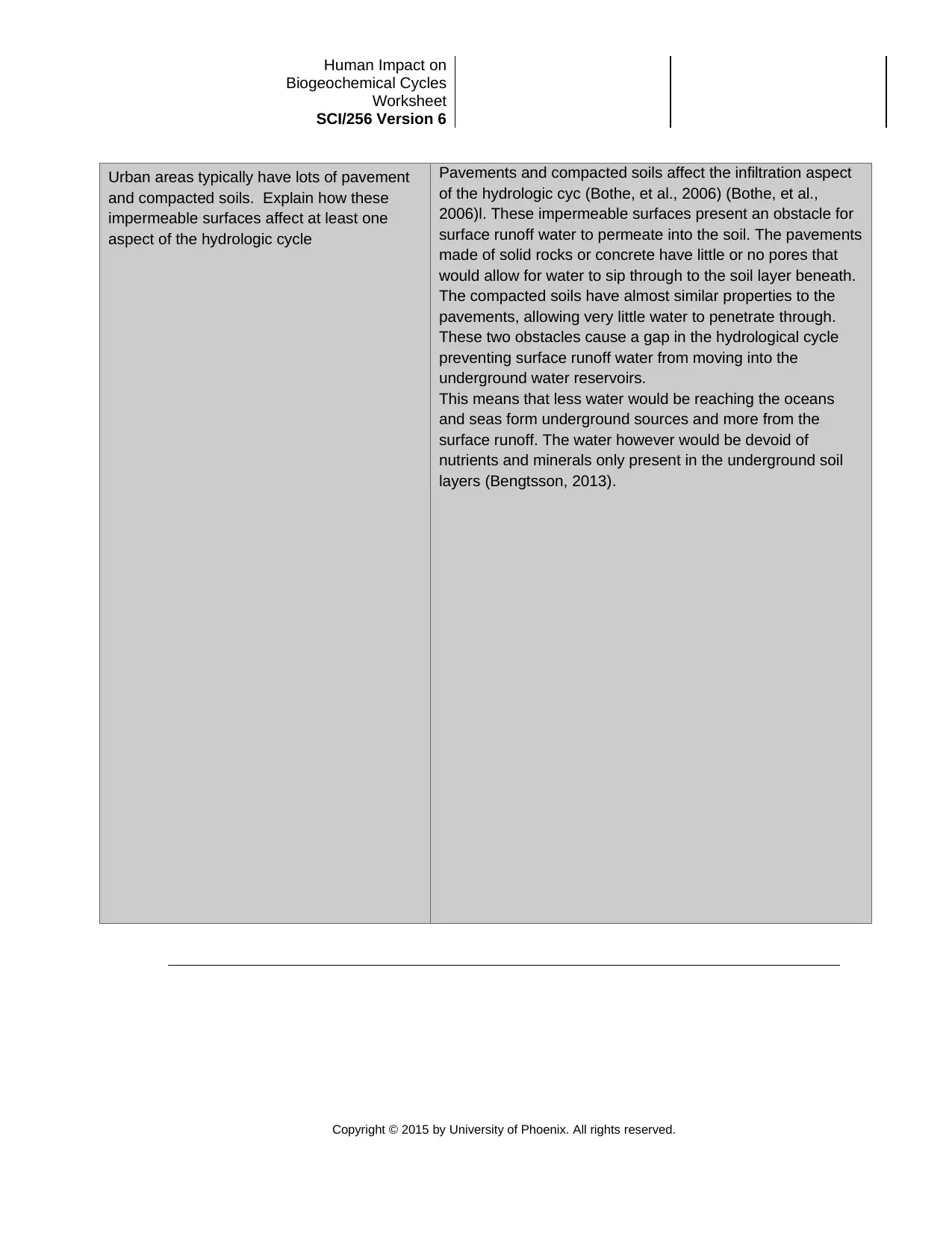
Human Impact on
Biogeochemical Cycles
Worksheet
SCI/256 Version 6
Urban areas typically have lots of pavement
and compacted soils. Explain how these
impermeable surfaces affect at least one
aspect of the hydrologic cycle
Pavements and compacted soils affect the infiltration aspect
of the hydrologic cyc (Bothe, et al., 2006) (Bothe, et al.,
2006)l. These impermeable surfaces present an obstacle for
surface runoff water to permeate into the soil. The pavements
made of solid rocks or concrete have little or no pores that
would allow for water to sip through to the soil layer beneath.
The compacted soils have almost similar properties to the
pavements, allowing very little water to penetrate through.
These two obstacles cause a gap in the hydrological cycle
preventing surface runoff water from moving into the
underground water reservoirs.
This means that less water would be reaching the oceans
and seas form underground sources and more from the
surface runoff. The water however would be devoid of
nutrients and minerals only present in the underground soil
layers (Bengtsson, 2013).
Copyright © 2015 by University of Phoenix. All rights reserved.
Biogeochemical Cycles
Worksheet
SCI/256 Version 6
Urban areas typically have lots of pavement
and compacted soils. Explain how these
impermeable surfaces affect at least one
aspect of the hydrologic cycle
Pavements and compacted soils affect the infiltration aspect
of the hydrologic cyc (Bothe, et al., 2006) (Bothe, et al.,
2006)l. These impermeable surfaces present an obstacle for
surface runoff water to permeate into the soil. The pavements
made of solid rocks or concrete have little or no pores that
would allow for water to sip through to the soil layer beneath.
The compacted soils have almost similar properties to the
pavements, allowing very little water to penetrate through.
These two obstacles cause a gap in the hydrological cycle
preventing surface runoff water from moving into the
underground water reservoirs.
This means that less water would be reaching the oceans
and seas form underground sources and more from the
surface runoff. The water however would be devoid of
nutrients and minerals only present in the underground soil
layers (Bengtsson, 2013).
Copyright © 2015 by University of Phoenix. All rights reserved.
Paraphrase This Document
Need a fresh take? Get an instant paraphrase of this document with our AI Paraphraser
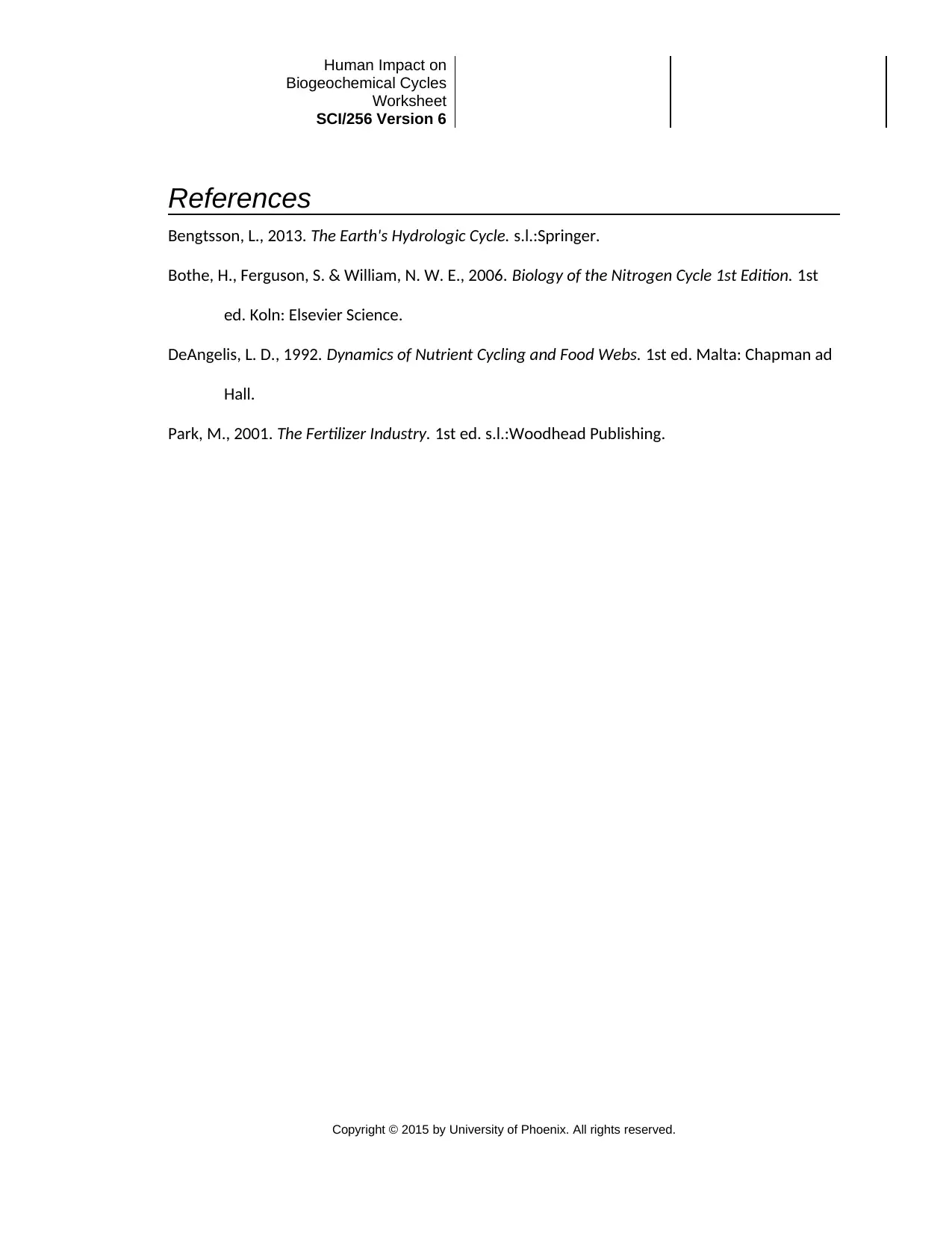
Human Impact on
Biogeochemical Cycles
Worksheet
SCI/256 Version 6
References
Bengtsson, L., 2013. The Earth's Hydrologic Cycle. s.l.:Springer.
Bothe, H., Ferguson, S. & William, N. W. E., 2006. Biology of the Nitrogen Cycle 1st Edition. 1st
ed. Koln: Elsevier Science.
DeAngelis, L. D., 1992. Dynamics of Nutrient Cycling and Food Webs. 1st ed. Malta: Chapman ad
Hall.
Park, M., 2001. The Fertilizer Industry. 1st ed. s.l.:Woodhead Publishing.
Copyright © 2015 by University of Phoenix. All rights reserved.
Biogeochemical Cycles
Worksheet
SCI/256 Version 6
References
Bengtsson, L., 2013. The Earth's Hydrologic Cycle. s.l.:Springer.
Bothe, H., Ferguson, S. & William, N. W. E., 2006. Biology of the Nitrogen Cycle 1st Edition. 1st
ed. Koln: Elsevier Science.
DeAngelis, L. D., 1992. Dynamics of Nutrient Cycling and Food Webs. 1st ed. Malta: Chapman ad
Hall.
Park, M., 2001. The Fertilizer Industry. 1st ed. s.l.:Woodhead Publishing.
Copyright © 2015 by University of Phoenix. All rights reserved.
1 out of 5
Your All-in-One AI-Powered Toolkit for Academic Success.
+13062052269
info@desklib.com
Available 24*7 on WhatsApp / Email
![[object Object]](/_next/static/media/star-bottom.7253800d.svg)
Unlock your academic potential
Copyright © 2020–2025 A2Z Services. All Rights Reserved. Developed and managed by ZUCOL.